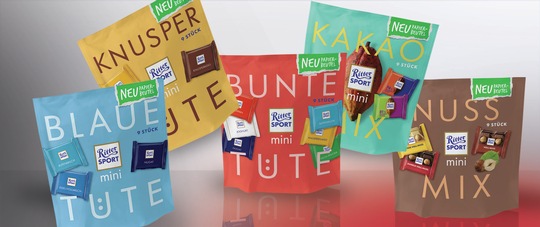 Packaging paper from Koehler for "mini Bunte Tüte" stand-up pouches
Packaging paper from Koehler for "mini Bunte Tüte" stand-up pouches
Ritter takes up changing consumer behaviour as a pioneer
Flexible packaging paper Koehler NexPlus® Seal is used for secondary packaging.
Changeover to paper stand-up pouches without major investment in packaging machines
Emotional and haptic experience with paper packaging creates new consumer experience
The goal of Alfred Ritter GmbH & Co. KG is packaging made from renewable raw materials that are in harmony with man and nature and can be recycled. With its almost 1,700 employees and a market awareness of 99 percent in Germany, the company is responding to a consumer behaviour that has grown exponentially in recent months. The idea of sustainability is becoming a weighty criterion in the purchase decision and refers not only to the actual product, but increasingly also to the outer packaging. Ritter is taking a leading role in addressing this change in consumer behaviour and is using the first secondary packaging made of paper.
Ritter is a pioneer in addressing changes in consumer behaviour
For its entire product range, the family-owned company Ritter exclusively sources certified sustainable cocoa. The use of plastic for product packaging is widespread in the FMCG sector. In order to be able to offer consumers a holistically sustainable product, Ritter began to question the use of plastic packaging in 2018. The advantage of alternatives such as paper was evaluated positively.
Sustainable packaging solution from Koehler as a replacement for plastic Duplex
With Koehler NexPlus®, the Koehler Group meets the rapidly growing demand for sustainable packaging solutions, not only from the food industry. Koehler NexPlus® are barrier-coated papers with various functionalities. These are, in particular, barriers for aromas, fat, mineral oil, water vapour and also for gases, which combine with the paper's own functionalities, such as high strength properties and the natural feel, to form a strong overall concept. The paper offers what is important for packaging: protection of the contents, protection of the environment and excellent processing properties.
The demands on packaging papers are high, as they should also fulfil all the functionalities that plastic duplex materials cover. This includes sufficient product protection, an attractive perception at the point of sale and, in addition, they serve as a communication instrument for ingredients, etc. Furthermore, in the best case scenario, the existing packaging lines should continue to be used without major adjustments when converting to paper.
Changeover of packaging without changing the packaging line
Ritter sells its products in over 100 countries worldwide. With only two production sites in Germany and Austria, the company serves the entire world market. Syntegon packaging machines are used at both locations. Moritz Steinle, Packaging Development Engineer at Alfred Ritter, explains: "We first ran several test runs with the NexPlus® Seal paper from Koehler, initially also without contents, and then made fine adjustments to get closer and closer to an optimal solution." The heat-sealing process in particular is essential for clean product packaging. "Sealing temperature, sealing time and sealing pressure must be optimally coordinated so that the packaging result seals cleanly. These are all criteria to which we attached great importance in the qualification process of the packaging material," Steinle continues. Koehler NexPlus® Seal Pure 65g/m2 is used for the mini Bunte Tüte. In the meantime, the flexible packaging paper from Koehler, but also the classic duplex plastic can be used on the packaging line from Ritter. This ensures continued flexibility.
The main advantage of Koehler NexPlus® barrier papers is that they are made from renewable raw materials. They can be fed 100 per cent into the recycling loop, which works for paper in many countries worldwide and is accepted by consumers. Eckhard Kallies, Division Manager Flexible Packaging Papers at Koehler emphasises: "In our view, the future belongs to barrier papers. Paper is increasingly taking on functionalities that only plastic could offer in the past. And paper, in contrast, fulfils a much more sustainable life cycle." The life cycle analysis of Koehler's flexible packaging papers shows significant CO2 savings compared to conventional papers with PE coatings, or even plastic duplex products.
Flexible packaging paper creates an emotional consumer experience
The use of paper as a packaging solution in the FMCG sector offers further advantages beyond the sustainability aspect. Tearing open a paper package gives the consumer an emotional and haptic experience that plastic solutions do not offer. The crackling of paper also conveys a positive sensory experience and is reminiscent of positive moments, such as the tearing open of wrapping paper. The positive consumer experience with the packaging radiates onto the product and an emotional connection is created.
Secondary packaging made of paper for Ritter Sport mini colourful bag
Sustainability and recyclability were the key requirements for the paper that Koehler developed together with Ritter. With success, because consumers can simply dispose of the mini bag in the waste paper bin, so that paper or cardboard can be made from it again. Eckhard Kallies states: "The trend in the choice of packaging is clear: paper scores points everywhere and is already actively contributing to the goals of the "circular economy". With our flexible packaging solutions made of paper, we reduce the proportion of plastic in product packaging and thus make the world a bit more sustainable."
The mini Bunte Tüte has been distributed in all international markets since January and has also been available in Germany since the beginning of March. Moritz Steinle adds: "The open and fast communication, but also the close coordination with Koehler were decisive for the successful implementation of this project. For Ritter, this is only the first logical step towards more sustainability in packaging. The first practical tests, also with primary packaging, have already been tested in the trade and have been enthusiastically accepted by consumers.
www.koehler.com


















































































